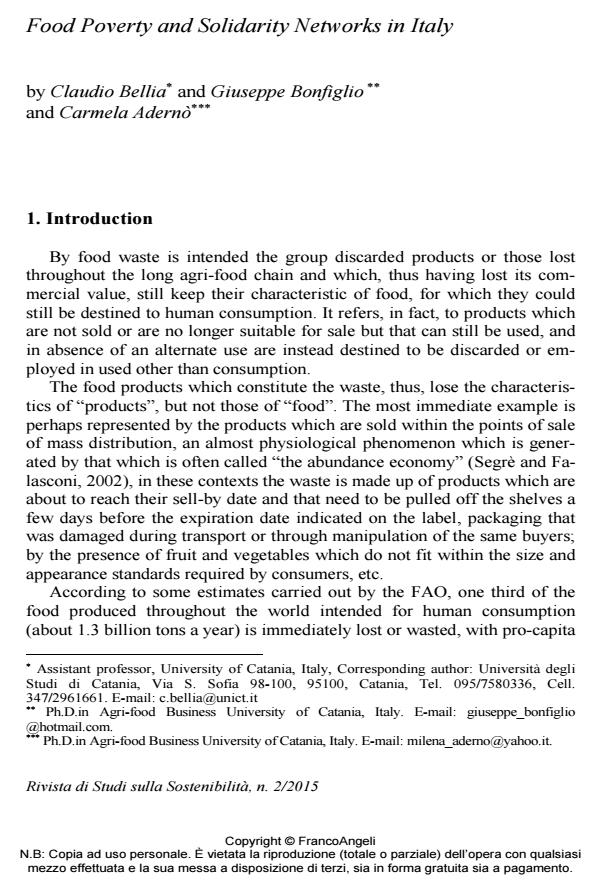Food Poverty and Solidarity Networks in Italy
Journal title RIVISTA DI STUDI SULLA SOSTENIBILITA'
Author/s Claudio Bellia, Giuseppe Bonfiglio, Carmela Adernò
Publishing Year 2015 Issue 2015/2
Language English Pages 18 P. 95-112 File size 198 KB
DOI 10.3280/RISS2015-002009
DOI is like a bar code for intellectual property: to have more infomation
click here
Below, you can see the article first page
If you want to buy this article in PDF format, you can do it, following the instructions to buy download credits

FrancoAngeli is member of Publishers International Linking Association, Inc (PILA), a not-for-profit association which run the CrossRef service enabling links to and from online scholarly content.
Among effects generated by the intense and prolonged financial, economic and labor crisis which has affected the economically advanced countries, we could also include on the one hand food poverty and on the other food losses and wastage that exist alongside the food system. The occurrence of Food Losses and Wastage assume different proportions in different regions of the world. According to FAO data, approximately 56% of Food Losses and Wastage occur in developed countries; the remaining 44% in developing countries. At the level of the final consumer in Europe we have a waste per capita of approximately 95-115 kg/year. What does it mean in terms of economic impact? From these data and questions, the present work describes the phenomenon of food poverty and solidarity networks, highlighting the role of AGEA and charitable institutions within the system of EU aid.
Keywords: Food poverty, food loose, food waste, third sector, solidarity networks, EU aid
- AA.VV. (2011). Global Food Losses and Food Waste. Extent, Causes and Prevention, FAO, Roma.
- AGEA (2013). Piano di distribuzione degli alimenti agli indigenti 2013 – consuntivo delle attività realizzate al 30.04.2013.
- Allegra V., Bellia C., Zarbà A.S. (2014). The logistics of direct sales: New approaches of the EU. Italian Journal of Food Science, 26 (4): 443-450.
- Barilla Center for Food and Nutrition (2010). Doppia piramide: alimentazione sana per le persone, sostenibile per il pianeta. Parma.
- Bellia C., Pilato M. (2011). Actuality and future prospects on GMos crops in agriculture: some main aspects and problems. Quality – Access to Success: 280-288.
- Bellia C., Pilato M. (2013). Considerations on the Changes in the Economic Land Use in Italy and the Corresponding Soil Consumption. In: Society, Integration, Education: Utopias And Dystopias In Landscape And Cultural Mosaic: Visions Values Vulnerability, Vol. V, Rezekne Higher Educ Institut, ISSN 1691-5887.
- De Castro P. (2004). Verso una nuova agricoltura europea. Agra, Roma.
- European Commission (2009). Eurobarometer Survey on poverty and social exclusion. 2010.
- European Commission (2010). DG Environment. Preparatory study on food waste across EU 27, Technical Report 2010-054.
- Fanfani R. (2009). Il sistema agroalimentare in Italia. I grandi cambiamenti e le tendenze recenti. Edagricole – Edizioni Agricole de Il Sole-24 Ore Business Media S.r.l., Milano: 191.
- FAO (2014). Food Wastage Footprint – full costs accounting final report. E-ISBN 978-92-5-108513-4 (PDF).
- Leisering, L. (2003). I due usi delle ricerche dinamiche sulla povertà. Modelli deterministici e contingenti delle carriere individuali di povertà. Sociologia e politiche sociali, 2.
- Segrè A. (2008). Elogio dello spreco. Formule per una società sufficiente. Emi, Bologna.
- Segrè A., Falasconi L. (2002). Abbondanza e scarsità nelle economie sviluppate. Per una valorizzazione sostenibile dei prodotti alimentari invenduti. FrancoAngeli, Milano.
- Segrè A., Falasconi L. (2011). Il libro nero dello spreco in Italia: il cibo (Vol. 12). Edizioni Ambiente, Milano.
- Tomei G. (2011). Guardare per pensare, agire per vedere. La valutazione delle reti di intervento sociale come strategia di disoccultamento dell’emarginazione grave. In: Pellegrino M., Ciucci F., Tomei G., Valutare l’invisibile. Interventi di contrasto alle povertà estreme a dieci anni dalla legge 328/2000. FrancoAngeli, Milano: 103-124.
- Tomei G., Natilli M. (a cura di) (2011). Dinamiche di impoverimento. Meccanismi, traiettorie ed effetti in un contesto locale. Carocci, Roma.
- Walker R., Leisering L. (2003). Verso una scienza sociale dinamica. Sociologia e politiche sociali, 2.
- Tourism in the Mediterranean Sea Manuela Pilato, Marco Platania, Hugues Séraphin, pp.257 (ISBN:978-1-80043-901-6)
- Rethinking IPRs on agro-biotechnological innovations in the context of food security Gabriella Vindigni, Giuseppe La Terra, in RIVISTA DI STUDI SULLA SOSTENIBILITA' 2/2017
DOI: 10.3280/RISS2016-002007
Claudio Bellia, Giuseppe Bonfiglio, Carmela Adernò, Food Poverty and Solidarity Networks in Italy in "RIVISTA DI STUDI SULLA SOSTENIBILITA'" 2/2015, pp 95-112, DOI: 10.3280/RISS2015-002009